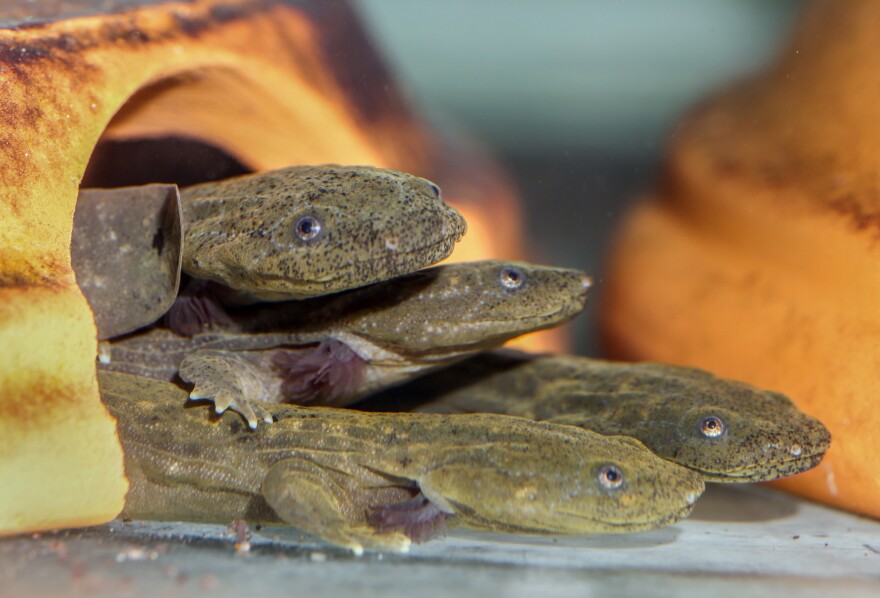BETHLEHEM, Pa. — Asked what makes the eastern hellbender — a species of giant salamander — unique, Sara Koplish described them as “ugly-cute.”
“I like to say that they are an ugly-cute animal — they're not everyone's cup of tea,” said Koplish, general curator at Lehigh Valley Zoo. “But, I think they're worth saving; they're important.
“They play a vital role in the environment. I think the biggest thing is that they serve as an indicator species. And, if we drop the ball on saving them, then we're gonna have a lot bigger problems in the future.”
A day after the U.S. Fish and Wildlife Service announced it’s collecting public input about listing the monarch butterfly under the federal Endangered Species Act, officials said they’re considering the eastern hellbender, too. If listed, hellbender populations — which have been in decline due to stream sedimentation, poor water quality, disease, habitat loss and pet trade collection — will get species-specific protections aimed at bolstering conservation efforts.
“The eastern hellbender is a unique salamander that plays a crucial role in maintaining healthy freshwater ecosystems,” said Will Meeks, the U.S. Fish and Wildlife Service’s Midwest regional director, in a press release.
“As key indicators of stream and river health, hellbenders need protection that also will help support healthier ecosystems across their range.”
A proposal to list the eastern hellbender as endangered was on Dec. 13 published in the “Federal Register.” Residents across the U.S. have until Feb. 11 to submit a comment.
'Pretty docile,' 'kinda slimy'
The largest salamander in North America, and the third largest salamander in the world, eastern hellbenders can be found right here in the Lehigh Valley — usually in or near its waterways.
“They pretty much follow the Appalachian Mountains,” said Koplish. In addition to Pennsylvania, they can be found in Alabama, Georgia, Illinois, Indiana, Kentucky, Maryland, Mississippi, Missouri, New York, North Carolina, Ohio, Tennessee, Virginia and West Virginia.
However, eastern hellbenders are the state amphibian for only one in their territory — Pennsylvania.
“Clean water is critical for the hellbender, and we need to continue to do our part to improve water quality in the commonwealth so that the first state amphibian can thrive.”Former Governor Tom Wolf
In early 2019, the state legislature approved a bill to make the eastern hellbender the commonwealth’s state amphibian. Then-Gov. Tom Wolf signed the bill into law wearing a “Hellbender Defenders” t-shirt, according to the Chesapeake Bay Foundation, a nonprofit involved in the effort.
“It’s about reaffirming our commitment to protecting our waters in Pennsylvania,” Wolf said during the signing. “Clean water is critical for the hellbender, and we need to continue to do our part to improve water quality in the commonwealth so that the first state amphibian can thrive.”
Clean water is the hellbender’s most basic need — they breathe through their skin. In good conditions, they can grow to be 12 to 29 inches long and weigh between 5 to 6 pounds. They’re known to live up to 30 years in the wild and spend their entire lives in water.
They’re not the most attractive of animals, depending on aesthetic tastes. Generally grayish to olive brown, hellbenders have sleek bodies, flat heads, stout legs and rudder-like tails.
They also have many nicknames, like: snot otter, devil dog, Allegheny alligator, mud devil, lasagna lizard, water dog, mud cat and walking catfish.
Describing them as “pretty docile” and “kind of slimy,” Koplish said residents could walk right by them without knowing it.
“They blend in well, so a lot of people don't even realize that they're in the streams if they're not really moving around,” she said. “They just look like nature. They camouflage really well.”
Habitat loss, pet trade
Because eastern hellbenders are so dependent on clean water, changes to their environment can prove disastrous.
“Like most species, habitat loss is pretty much number one for them, because they need super clean water to survive,” Koplish said. “So, pretty much anywhere that there's pollution or disturbances, it just does not become a suitable habitat for them anymore.”
Historically, eastern hellbenders have been documented in 626 populations, according to data from the U.S. Fish and Wildlife Service.
However, the most recent data indicates only 371 of these populations, or about 59%, remain.
“Among the remaining populations, only 45 (12%) are stable, 108 (29%) have an unknown recruitment status, and 218 (59%) are in decline,” officials said.
“They have a nice, long lifespan, so they should be living a long time,” Koplish said. “And what we're seeing now is a huge decrease in populations, and that's due to, mostly, pollution and habitat loss.
“So, pretty much what we're seeing is just dirty, contaminated water causing habitat loss. The hellbender serves as a really good indicator species that would show us when these ecosystems are declining and not able to allow an animal like this to survive in it, when they really should be thriving and living these long lives.”
Because hellbenders are so sensitive to minute changes in their environment, they’re often looked at as the bellwether of things to come.
“... We want to stop, or inhibit, habitat loss for this animal as early on as we can because clearly things are already taking effect.”Sara Koplish, Lehigh Valley Zoo
“Animals like that are very sensitive to changes in their environment, are like a good indication that something is definitely wrong with that environment,” she said. “And, because they are so sensitive to it, they're probably one of the first ones we'll see where their numbers are decreasing
“... We want to stop, or inhibit, habitat loss for this animal as early on as we can because clearly things are already taking effect.”
In addition to habitat loss, the pet trade has also made a dent in hellbender populations — similar to hermit crabs.
“A lot of times, what ends up happening is, with animals like this, it's easier to catch them in the wild than it is to breed them,” she said. “So, a lot of places, people will unfortunately just go out, catch what they can out of a stream, if they know that there's a population there, and then sell them as pets to people, and sometimes people who even buy them don't even realize pretty much what they're buying into.”
There are eastern hellbenders on exhibit at the Lehigh Valley Zoo, 5150 Game Preserve Road, in the Schnecksville section of North Whitehall Township.
“We have two of them,” said Koplish. “They both live together in one of our habitats and our Reptile and Amphibian Discovery Center — we call it RAD.
“They're out year-round. A lot of times people are like, ‘They're not in there.’ And I'm like, ‘Yes, they are. You just need to look again. That is not a rock, that is an animal there.’ Because, like I said, they blend in, and even when people are looking for them, they have a hard time seeing them.”


